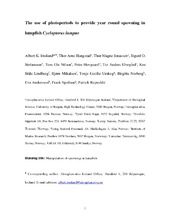| dc.contributor.author | Imsland, Albert | |
| dc.contributor.author | Hangstad, Thor Arne | |
| dc.contributor.author | Jonassen, Thor Magne | |
| dc.contributor.author | Stefansson, Sigurd Olav | |
| dc.contributor.author | Nilsen, Tom Ole | |
| dc.contributor.author | Hovgaard, Peter | |
| dc.contributor.author | Elvegård, Tor Anders | |
| dc.contributor.author | Lindberg, Ken Ståle | |
| dc.contributor.author | Mikalsen, Bjørn | |
| dc.contributor.author | Urskog, Tonje Cecilie | |
| dc.contributor.author | Norberg, Birgitta | |
| dc.contributor.author | Andersson, Eva | |
| dc.contributor.author | Spetland, Frank | |
| dc.contributor.author | Reynolds, Patrick | |
| dc.date.accessioned | 2020-04-17T11:08:29Z | |
| dc.date.available | 2020-04-17T11:08:29Z | |
| dc.date.issued | 2019 | |
| dc.Published | Imsland A, Hangstad TA, Jonassen TM, Stefansson SO, Nilsen TO, Hovgaard P, Elvegård TA, Lindberg, Mikalsen B, Urskog TC, Norberg B, Andersson E, Spetland F, Reynolds P. The use of photoperiods to provide year round spawning in lumpfish Cyclopterus lumpus. Comparative Biochemistry and Physiology A. 2019;228:62-70 | eng |
| dc.identifier.issn | 1531-4332 | en_US |
| dc.identifier.issn | 1095-6433 | en_US |
| dc.identifier.uri | http://hdl.handle.net/1956/21918 | |
| dc.description.abstract | In order to provide year round spawning broodstock, lumpfish (initial size 746 g and 24.9 cm) were reared under four different photoperiod regimes from January 2017 to July 2018. One group was reared under simulated natural photoperiod (LDN, control group) for Tromsø (70°N). The second group was transferred to continuous light (LD240) on 30 January 2017 and reared at LD24:0 throughout the trial period. Two compressed and phase advanced photoperiods were also established. Both groups were moved from LDN to LD24:0 on 30 January 2017, and after that reared at compressed natural photoperiods where the annual photoperiod was compressed down to six months (L6) or nine months (L9) for the duration of the study. Spawning time was shifted in both compressed groups during both years of the study. Spawning activity in the second year of the study was higher and followed more closely the expected spawning period in the compressed and the LDN groups. Spawning in the LD240 group was spread out over the experimental period with no distinct peak in spawning. A seasonal and pronounced drop in condition factor was found for females in the L9, L6 and the LDN groups. This post-spawning loss in condition was closely related to the spawning activity of each group. The current findings suggest that photoperiod has a strong influence on the timing of lumpfish maturation and can be used as an efficient and inexpensive tool to secure lumpfish reproduction operations i.e. year-round supply of egg and milt and/or timing with optimal temperature regimes. | en_US |
| dc.language.iso | eng | eng |
| dc.publisher | Elsevier | en_US |
| dc.rights | Attribution CC BY-NC-ND | eng |
| dc.rights.uri | http://creativecommons.org/licenses/by-nc-nd/4.0/ | eng |
| dc.title | The use of photoperiods to provide year round spawning in lumpfish Cyclopterus lumpus | en_US |
| dc.type | Peer reviewed | |
| dc.type | Journal article | |
| dc.date.updated | 2020-01-21T17:31:53Z | |
| dc.description.version | acceptedVersion | en_US |
| dc.rights.holder | Copyright 2018 Elsevier | en_US |
| dc.identifier.doi | https://doi.org/10.1016/j.cbpa.2018.11.004 | |
| dc.identifier.cristin | 1692614 | |
| dc.source.journal | Comparative Biochemistry and Physiology A | |
| dc.relation.project | Norges forskningsråd: 256199 | |

